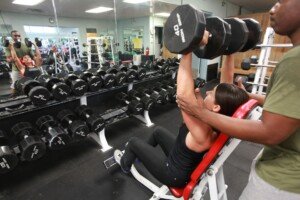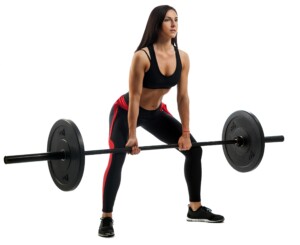
If a woman had to choose just one type of strength training, should it be free weights or machines?
After all, there are advantages – and disadvantages – to both approaches of resistance training.
Benefits of Free Weights for Women
• More muscles are engaged; you’re forced to balance and guide the free weights through the air, meaning that you’re working in more ways against gravity.
• This not only engages the primary mover muscles for the particular exercise, but it activates secondary assister muscles.

• With free weight training, many more secondary or assistive muscles are used when compared to machine workouts. This means more calories are burned and a higher degree of neuromuscular training is achieved.
• This includes engagement of the core muscles.
• The joints are worked more completely, leading to stronger tendons and ligaments.
• Much more range of motion is possible. It’s nearly limitless.
• When compared to machines, free weights are far better for strengthening a woman’s grip.

Shutterstock;Everyonephoto Studio
• You can meld exercises into one routine, such as going from a dumbbell shoulder press straight into a dumbbell biceps curl.
• Real-life movements can be mimicked with free weights.
• There is far more variety than what machines can offer, even if the gym floor is cluttered with endless rows of machines.
Downside to Free Weights
• Adhering to strict form is far more relevant to reduce the risk of injury.
• And of course, there is an inherently higher risk of injury anyways.
• Entries and exits into heavy dumbbell exercises can be tricky, and sometimes the entries are difficult.
• Women with low back pain will find that some exercises aggravate the condition.
• Unfortunately, many women still associate free weights with becoming too muscular.
• For some women, use of free weights is associated with what they think will be difficult-to-learn movements, when in fact, this is mostly an illusion.
Advantages of Machine Strength Training for Women
• Most machines have basic instructions printed out including which muscles are targeted.
• The body is more stabilized with better posture, and there are pads to support the body against.

Shutterstock/ Travelerpix
• The targeted muscles are more isolated in the movement.
• If the resistance suddenly becomes too heavy to lift, you don’t need to worry about it coming crashing down on you or dropping a weight on your foot.
• Entries and exits involving heavy lifts are very doable, reducing the need for a spotter.
• Injury risk is lower.
• Machine workouts are friendlier to those with low back pain.
Downside to Resistance Machines
• Most machines do not mimic the movements of real life against resistance, such as lowering yourself to pick something heavy off the floor.
• Though many makes and models of machines are out there, the number of options is still a lot less than with free weights.
• Don’t you hate when, upon approaching a machine that you want to use, there’s a sign on it that says “Out of order”?
• Not enticing to very large women who believe that they may not be able to fit into the equipment.
When I was a personal trainer, I had my clients — both female and male — using a combination of free weights and machines.
But if I had to choose between which was better, if you had to stick with either one or the other, I’d definitely go with free weights.
This means barbells, dumbbells, kettlebells, heavy balls and body weight.
 Lorra Garrick is a former personal trainer certified through the American Council on Exercise. At Bally Total Fitness she trained women and men of all ages for fat loss, muscle building, fitness and improved health.
Lorra Garrick is a former personal trainer certified through the American Council on Exercise. At Bally Total Fitness she trained women and men of all ages for fat loss, muscle building, fitness and improved health.
.








































